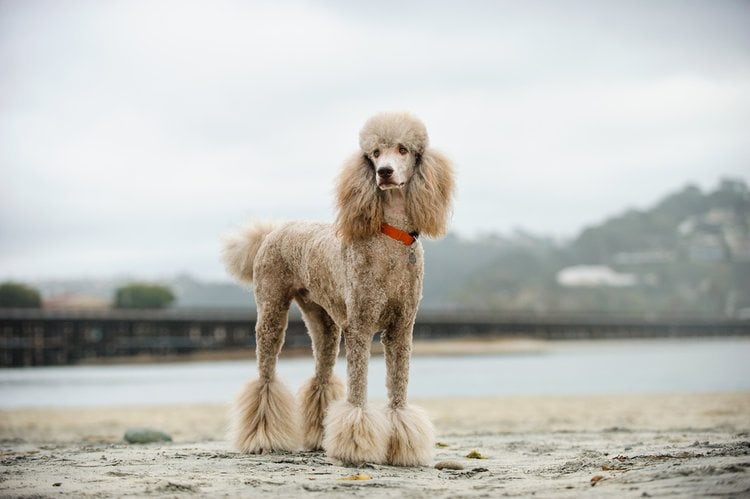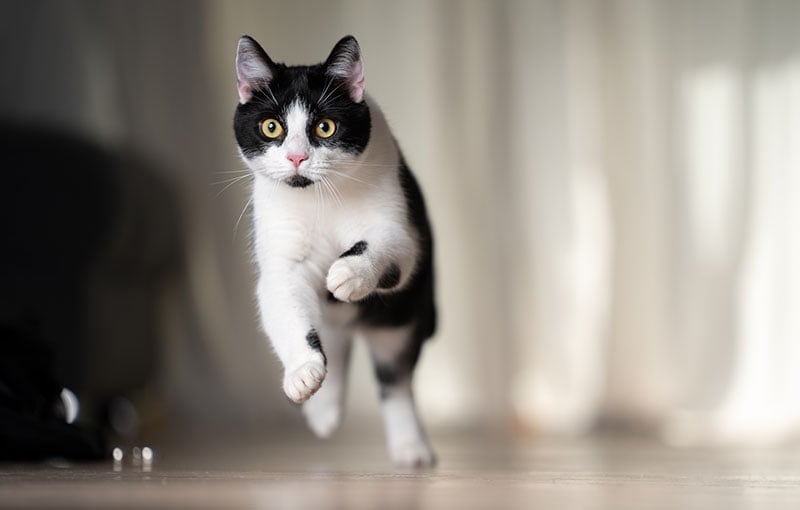How Long Do Munchkin Cats Live? Average Lifespan, Data & Care

Updated on
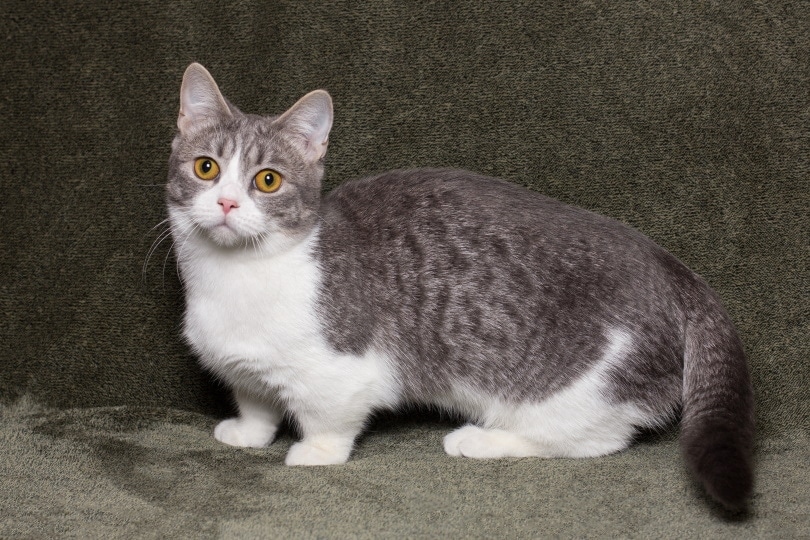
Munchkin cats are unique felines known for their dwarfism. The energetic, fun-loving cat is relatively new and controversial, especially regarding their breeding. Despite having short legs, Munchkins are well-known for their speed.
With many issues focused on their health and genetic mutation, there’s always concern about how long the Munchkin cat lives. With proper care and good health, a Munchkin cat has an average lifespan of 12-15 years.
Origins of the Munchkin
Munchkin cats are a short-legged breed that was discovered in Louisiana in 1983. Their short limbs are due to a genetic disorder known as pseudoachondroplasia, a form of dwarfism. The breed sprung up as a result of spontaneous natural genetic mutation.
Similar short-legged cats were reported in the 1930s in Great Britain, Russia, and New England. The modern-day Munchkin cat descended from a pregnant stray cat known as Blackberry, which was one of the two kittens rescued by a music teacher named Sandra Hockenedel in Rayville, Louisiana, in the early 1980s.
After the birth of the kittens, she gave out one of the short-legged kittens, Toulouse, to her friend Kay LaFrance. Blackberry and Toulouse became the founders of the breed. From this initial breeding, Sandra and LaFrance established a breeding program for Munchkin cats with other breeders.
The International Cat Association (TICA) Recognition and Controversy
Controversies surround the Munchkin, and they are still not accepted by some cat associations. These debates arise from concerns about whether it’s ethical to continue breeding while having a physical deformity that affects their mobility and lifespan. The cat’s short body results from a genetic mutation that happens naturally.
The Munchkin was introduced to the general public by a live cat show held by TICA in Madison Square Garden, New York City, in 1991. By 1994, it was proposed as an official breed and accepted into TICA’s New Breed development program.
This introduction sparked an uproar due to the cat’s physical shape. However, it was not until 2003 that the Munchkin achieved TICA Championship status and recognition.
Due to health and welfare concerns, many people today still argue that breeding the Munchkin is unethical. However, on the other hand, experts say the breed is healthy. This controversy has contributed to the lack of recognition by the world’s largest cat organizations, including the Cat Fanciers Association (CFA) and the American Cat Fanciers Association (ACFA).
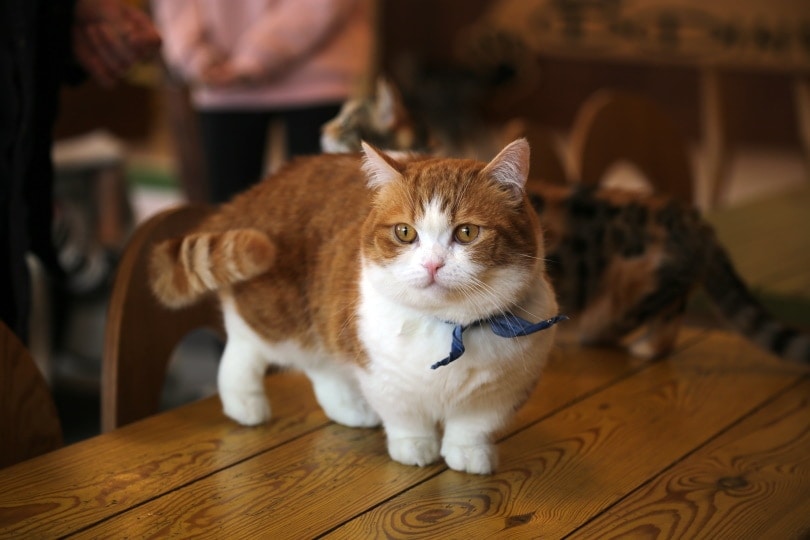
Physical Traits
The Munchkin’s most distinguishing feature is their short legs. The limbs appear bow-legged and are typically half as long as a regular cat’s. They have ordinary features apart from the legs, though they might look like a kitten for their entire lifespan.
The medium-sized cat is firmly muscled with a well-rounded chest. It comes with a flat back with a slight rise from the shoulders to the rump. Their head has rounded contours with medium ears that are broad at the base.
The Munchkin comes in a variety of patterns, colors, and fur lengths. The coat can either have long or short hair.
Munchkin Cat Facts
- The Munchkin Name
It’s believed that the Munchkin was named after the famous characters from the novel and classic film The Wizard of Oz.
- The World’s Shortest Cat
In 2013, the Guinness World Records named Lilieput, a female Munchkin cat from Napa, California, as the shortest living cat on record. The cat measured 13.34 cm (5.25 in) from the bottom of her paws to the shoulders.
- Celebrity Ownership
Heiress and socialite Paris Hilton owns two Munchkin cats named Shorty and Munchkin. She has contributed to the popularity of the breed.
- Three Leg Lengths
Munchkin cats are born with three leg lengths: the standard, super short, and the rug hugger.
The standard category includes those cats in the litter born with the heterozygous gene. Their legs are only slightly shorter than those of a cat not carrying the heterozygous gene. They have the longest legs. The super-short are born with moderately short legs, while the rug hugger has the shortest limbs.
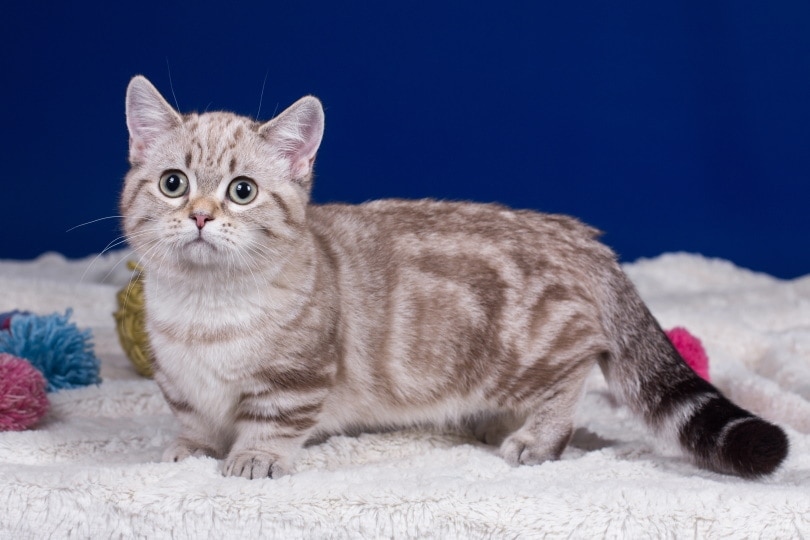
Health Conditions
When taken care of well, Munchkins can live 12 to 15 years on average. Despite that, they are prone to health problems due to their short legs, which could result in a shortened lifespan.
- Lordosis
Lordosis is a condition whereby the spinal muscles don’t grow long enough. This causes the spine to shrink slightly downwards, putting pressure on the heart, lungs, and trachea. As the organs grow, it can be fatal.
The condition can be mild to moderate; however, most severe cases occur in kittens. When it becomes severe, the kittens won’t live past 12 weeks, whereas those suffering from a mild form of the condition will live a normal life but may suffer from shortness of breath during intense physical activity.
- Pectus Excavatum
This deformity is also known as the concave chest. It causes the cat’s breastbone to sink inwards. Breeders argue that this condition is not specific to this breed only; therefore, it can’t be entirely blamed on the genetic mutation.
- Arthritis
The short legs put the Munchkin cat at high risk of getting arthritis, which is a painful and degenerative condition of the joints.
- Retina Atrophy
Munchkin cats can suffer from a group of inherited retinal diseases characterized by progressive retina degeneration. Since it’s responsible for receiving light from the front of the eye, it results in eye conditions.
- Breeding Risk
The Munchkin’s short legs result from a dominant gene mutation. It’s referred to as the lethal gene, and it’s fatal to breed two Munchkins. When two Munchkin cats mate and pass the dominant gene to their offspring, the kittens will have a high mortality rate. Kittens with two copies of the gene will die before birth, while kittens with only one copy (heterozygous) are born with short legs.
To prevent this, breeders avoid using Munchkin cats with the short-legged gene but instead breed them with regular-sized cats or naturally shorter breeds. With this tactic, only one parent has the mutation; therefore, the kitten can survive.
- Inability to Jump
Because of their shortened legs, Munchkin cats may not be able to jump as high as their regular longer-legged feline friends.
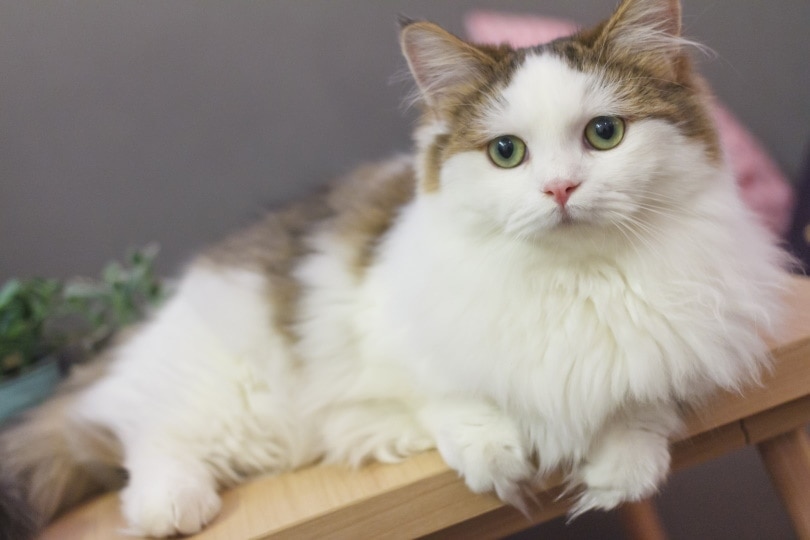
What Factors Can Shorten Your Munchkin Cat’s Lifespan
With a lot of controversy revolving around the health of this breed, there are concerns about how that affects their average lifespan.
As a relatively new breed, there is limited data to come up with solid conclusions. However, some known factors could affect how long your Munchkin cat lives.
- Genetic Disorders
The gene mutation is a huge concern for the Munchkin. It’s fatal to breed two Munchkins with the gene mutation because some of the kittens will not survive.
- Obesity
If your cat is on an unhealthy diet or doesn’t exercise, the chances are that they are more likely to be obese. With their short stature, the Munchkin is at a higher risk of developing other health issues due to obesity. The extra weight puts more pressure on the legs and can result in joint problems.
- Poor Diet
Like any other cat, the Munchkin requires a well-balanced diet. Cat owners must research the most suitable cat food for their cats to get proper nutrition. If properly fed, your cat will live a longer life.
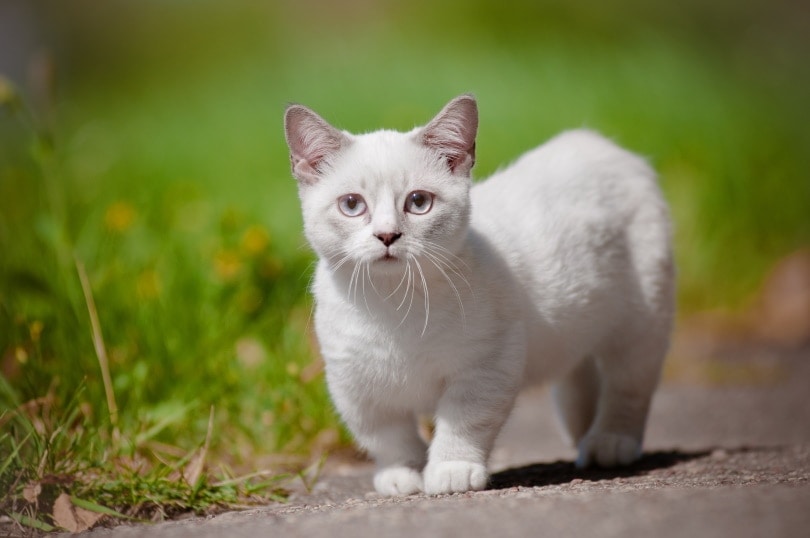
How Can You Increase the Munchkin Cat Lifespan?
Your Munchkin cat can live a happy and long life if well cared for. Here are some things you can do.
1. Schedule Exercise Sessions
Even though Munchkins are small, they need to move and exercise. Like other cats, they need mental and physical activities to keep them occupied. This will contribute to their well-being and overall health. Luckily, they are playful and run around the house or yard since they have incredible speed.
They are curious and intelligent; you can add interactive puzzle games to keep your cat entertained.
2. Plan a Healthy Diet
We’ve established poor nutrition could reduce the average lifespan of your Munchkin cat. Therefore, your pet needs a good nutrition guide to help with growth. You can consult your vet for proper advice.
3. Frequent Health Check-Ups
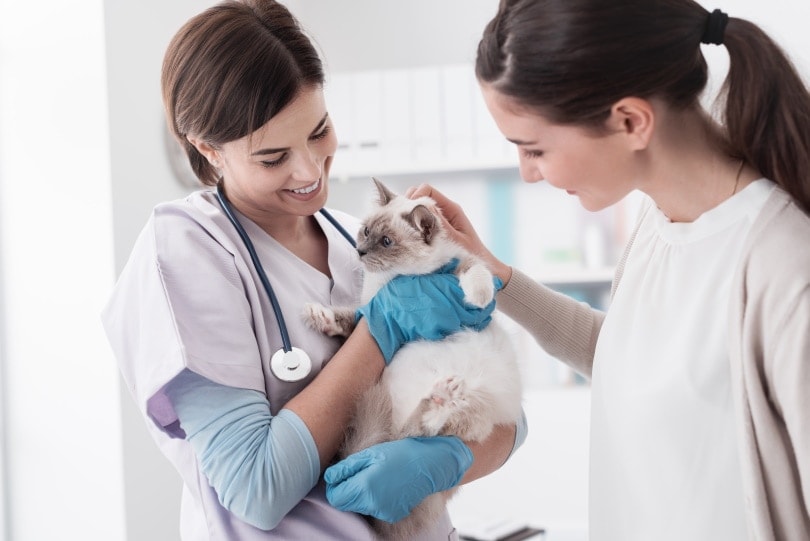
Due to the medical issues they face, you can schedule regular check-ups with the vet. Frequent check-ups and vaccines will reduce the chances of your cat suffering from a chronic disease.
In addition, you should keep a close eye on your cat to spot any changes in the body that can affect their health. Visit the vet immediately if you spot any troubling signs.
4. Neuter or Spay Your Cat
For any breed, the spayed or neutered cats tend to live longer.
5. Keep Your Cat Indoors
Indoor cats live longer than cats that spend most of their time outdoors. Consider keeping your Munchkin indoors to keep them safer and less exposed; they might live longer.
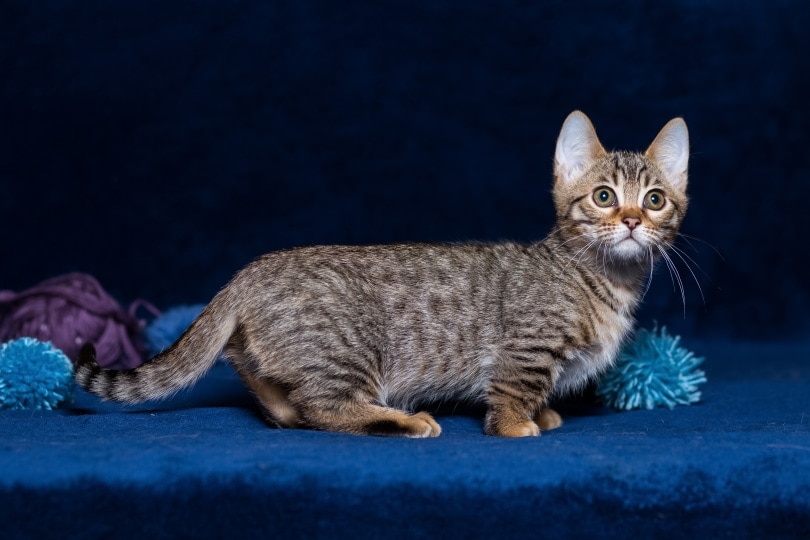
6. Proper Home Care
Ensure your cat is well taken care of and groomed to maintain their health and well-being. You can brush their coat weekly for shorthaired cats or daily for longhairs to prevent matting.
It’s critical to maintain their dental care to prevent gum disease, and you can brush their teeth a few times a week to keep them healthy. Even when staying indoors, your cat could still catch fleas and parasites, but preventative medications can protect them.
If you are not in the house for extended periods, consider getting two Munchkin cats for companionship.
Summary
Munchkin cats are known for their unique appearance. Despite the controversies, they make great pets if well taken care of. You can enjoy living with them for 12 to 15 years by keeping them healthy.
Due to their genetic mutation and increased health risk, you’ll need to closely monitor any body changes and schedule regular check-ups with the vet to ensure they are healthy. As long as the health of your Munchkin cat is a priority, your feline friend will enjoy a long life.
See Also:
Featured Image Credit: SV_zt, Shutterstock

